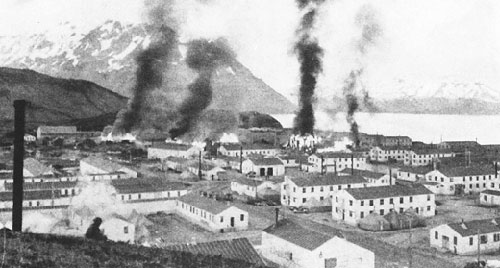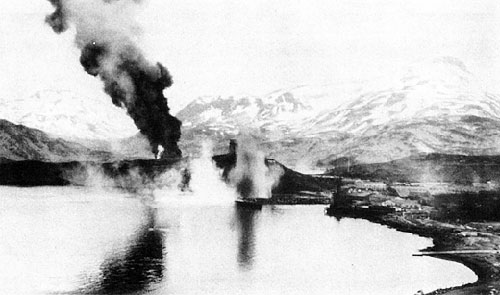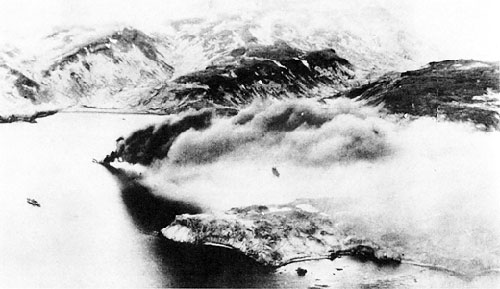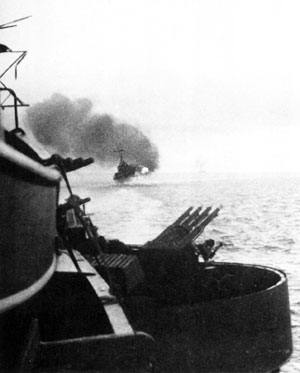
THE DUTCH HARBOR WAR
June 01, 2012
Burning buildings at Ft. Mears after first enemy attack on Dutch Harbor, 3 June 1942....
The fog was dense in that first enemy attack on Dutch Harbor (as it often is), the seas rough, and only 17 of the enemy planes reached their targets. The others got lost in the Aleutian's incredibly thick murkiness, and some crashed into the sea. The Japanese planes returned the next day, June 4, and their bombs set oil tanks afire, damaged the hospital and a barracks ship. American casualties numbered 33 military and ten civilian dead, 64 wounded, and 11 U.S. planes (from Umnak Island) were lost.
Japanese bombing of Dutch Harbor, 4 June 1942... Two days later, June 6, the enemy occupied Kiska and the following day troops invaded Attu, both of the islands located on the western end of the Aleutian Chain. They met no resistance from the small bands of surprised Aleuts, and a missionary family. They were sent to prisoner of war camps in Japan to spend the remainder of the war. The evacuation of the islands Aleut people followed, which removed them to locations in Southeastern Alaska - one of them the camp at Ketchikan's Wards Cove. The year-long fighting that followed the enemy attack, invasion and occupation in Alaska stretched along a thousand-mile front that would be the site of the only World War II land battles on the North American continent! North America's attic door had been blasted open! The battle was hampered by the area's devilish weather that hampered activities on land and sea, for both sides. Ketchikan's initial and slightly disorganized civil defense efforts in those first months of the war had smoothed into routine by the summer of 1942. Emergency defense plans were in place to fight fires. Business owners had barrels of sand hauled to rooftops to fight fires caused by incendiary bombs, and the experienced but aging volunteer firemen - beyond military service age - were prepared. Air raid drills were common, and many people took first aid classes. At Main School air raid evacuation drills ushered kids to the Schoenbar gold mine tunnel in Bear Valley. Air raid wardens patrolled the streets at night. It was a time of blackout along the western shores of the United States from Alaska to San Diego, including Ketchikan. Blackout curtains or window shades were required after dark. The late Ted Ferry once told of building a blackout entrance to Ferry's food store on the curve of Water-Tongass Avenue, so that customers could come into and out of the store after dark without leaking any light.
Japanese transport burning after U.S. air attack on Kiska Harbor, 18 June 1942... Rumors abounded. From the beginning, there had been fearful stories of Japanese cannery workers suspected of having secret short-wave radios to beam traitorous messages to the enemy. While that local fear of the enemy didn't extend to Ketchikan's own Japanese-American citizens, nonetheless they were rounded up, as were others all along the Pacific Coast, and placed in detention camps in Arizona and elsewhere in land. Ketchikan's "detained" people numbered 42, according to a Ketchikan Chronicle story - nine businessmen, eight other adults, and 25 children. Ironically, it was Pat Hagiwara, Kayhi class of '36 - among the first wave of Ketchikan boys to join the Army and a son of one of those relocated Ketchikan families - who was assigned to shepherd friends and relatives to the boats that would take them south. The Ketchikan families were also fortunate that friends cared for their properties until war's end, when the families returned. Others in California and elsewhere were not so fortunate. At the same time, other sons of military age of these Japanese-descended families were joining America's military forces and serving in positions of responsibility and honor, some of them in units that were the most highly decorated of the war. Pat Hagiwara, while no longer living in Ketchikan, was later instrumental in putting together the "Kayhi Alumni Directory," which includes classes from 1922-1945, a monumental task.
By that summer of '42 the rosters of Ketchikan noted a shrunken resident male population, many of the hometown boys serving in the Aleutian theater of war. Still, with airfield and housing construction on the Annette Island bomber base, the streets were crowded with servicemen and construction workers on R&R. The Ketchikan USO - later the town's civic center and now just a snaggle of piling next to Casey Moran city float - offered temporary shelter from the rain, a room for letter writing and snacks as well as dances with young lady hostesses. Romances blossomed among enterprising high school girls who learned semaphore signals so they could send messages to their boyfriends coming in by boat from Annette. Hometown boys of the right ages were in short supply. Most of the hometown boys, many of them members of the 297th of the Alaska National Guard, had been sent to the Chilkoot Barracks at Haines during the November of '41, just before the Pearl Harbor attack. Or, they later joined the familiar Coast Guard, branches of the Army or Navy or the Army Air Corps - the forerunner of today's U.S. Air Force. They served honorably and well. Their names are too numerous to mention. U.S. Forces in May of 1943 reclaimed Attu in the only major land battle of war fought on American soil! Kiska was reclaimed in August, Americans discovering that 5,000 enemy troops had already been evacuated from the island some weeks before. Aleut families in camps in Southeastern were returned to their homes in the Aleutians, if they chose to go back. Some stayed. The Alaska conflict was a brief war, a frustrating and little-known segment of a larger world war in which the weather proved to be the most powerful enemy of all. Some historians say it was a fragment in the turning point of the entire Pacific conflict. Gradually and at great cost the U.S. gained ascendancy that led to Japan's surrender in August 1945. There are other stories, too. Why did Japan deploy even a fragment of its powerful fleet and aircraft to Alaska, to little-known and sparsely populated islands of small significance? There is one interesting speculation about that. It is that the 1942 Japanese attack on Alaska's Aleutian Islands was in response to the April 1942 American bomber raid on Tokyo. Daredevil Jimmy Doolittle masterminded the April 1942 retaliation for Pearl Harbor with his audacious bombing of Tokyo, a feat memorialized in the movie "30 Seconds Over Tokyo." With 16 B-25s, Doolittle led the raid on five Japanese cities, including Tokyo! Fifteen of those planes safely crash-landed in China, the 16th in the Soviet Union. You see, Jimmy Doolittle, who was promoted to general because of that raid, spent his boyhood in Alaska, in Gold Rush Nome! Could it be? Maybe. Maybe not.
From the Editor: Governor Sean Parnell has ordered state flags to be lowered to half-staff on Sunday, June 3, 2012 to mark the 70th anniversary of the bombing of Dutch Harbor during World War II. On June 3, 1942, the Japanese bombed Dutch Harbor on Amaknak Island. State flags should be returned to full-staff on Monday, June 4.
Editor's Note:
Related:
E-mail your news &
photos to editor@sitnews.us
|
|||



